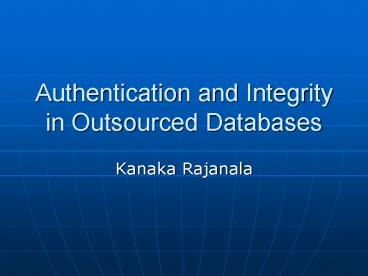Authentication and Integrity in Outsourced Databases - PowerPoint PPT Presentation
1 / 21
Title:
Authentication and Integrity in Outsourced Databases
Description:
Authentication and Integrity in Outsourced Databases. Kanaka Rajanala ... Organizations outsource their data management needs to an external provider. ... – PowerPoint PPT presentation
Number of Views:36
Avg rating:3.0/5.0
Title: Authentication and Integrity in Outsourced Databases
1
Authentication and Integrity in Outsourced
Databases
- Kanaka Rajanala
2
What is Outsourced Database
- Organizations outsource their data management
needs to an external provider. - The service provider hosts client database and
offers mechanisms. - Create databases
- Updating
- Storing
- Accessing (querying)
3
Advantages of ODB
- The organizations can concentrate on their core
tasks and operate their business applications via
Internet. - Dont worry about
- Deployment, instillation, maintenance ,upgrades.
- Hire, train/retain people.
4
Challenges
- Overall performance
- Scalability
- Usability
5
Challenges
- Privacy/Security
- Protection of outsourced data from intruders and
attacks. - Protecting clients from misuse of data by service
providers. - Ensuring integrityprivacycompleteness of query
replies.
6
Goal
- This paper investigate techniques to help ODB
client authenticate the origin and verify the
integrity of data returned by the service
provider in response to a posed query.
7
System Model
- ODB is an example of Client Server model.
- Types of ODB
- Unified Client Model
- Multi Querier Model
- Multi Owner Model
8
1. Unified Owner Scenario
Server Site
Server
Data Deposit Queries
Encrypted User Database
A single entity creates, queries, manipulates
the database.
9
2. Multi-Querier Scenario
Server Site
Data Deposit queries
Server
Encrypted User Database
Data Queries
10
3. Multi-Owner Scenario
Server Site
Server
Encrypted User Database
Data Deposit queries
Data Queries
11
Why do we need Integrity
- In some occasions where we may not want secrecy
but want integrity - Every one is allowed to read a message
- But no one is allowed to modify it.
12
Why do we need Authentication
- To authenticate the source of data.
- The main goal is to assure ODB clients that the
data they receive from the server has not be
tampered from an external adversary or the server
itself.
13
Granularity of Integrity
- Table level-impractical for large tables.
- Column level-very expensive for the owner in
terms of computation. - Optimal is to provide integrity at row level.
14
Overhead Factors and Desired Features
- Querier computation
- Querier bandwidth
- Server computation
- Owner computation
- Server storage
15
MACs or Signatures
- With MAC client can ask server to store record
along with MAC. - Works for Unified Client model where owner and
querier are same. - Cannot be worked with other models
- MAC key to be shared between all owners and
queriers. - Non repudiation of queries cannot be achieved.
16
Standard RSA
17
Condensed RSA
- Server
- Selects records matching posed query
- Multiplies corresponding RSA signatures
- Returns single signature to querier
Server
Querier
Given t record signatures s1, s2 st ,
compute combined signature s1,t ?si mod n
Send s1,t to the querier
Given t messages m1,m2 mt and s1,t verify
combined signature (s1,t)e ? ? h(mi) (mod
n)
s1,t
18
Condensed RSA
- Reduced querier computation costs
- Querier performs (t-1) mult-s and a one
exponentiation - Constant bandwidth overhead
- Querier receives a single RSA signature
- As secure as batch RSA (with FDH)
- Not efficient for Multi-Owner model
19
Batch Verification of RSA Signatures
- Batching useful when many signature
verifications need to be performed simultaneously - Reduces computational overhead
- By reducing the total number of modular
exponentiations - Fast screening of RSA signatures
- Given a batch instance of signatures s1, s2
st on distinct messages m1, m2 mt
where h() is a full domain hash function
20
Fast Screening
- Reduces (somewhat) querier computation but not
bandwidth overhead - Individual signatures are sent to the querier for
verification - Bandwidth overhead can be overwhelming
- Consider weak (anemic) queriers
- Query reply can have thousands of records
- Each RSA signature is at least 1024 bits!
21
Cost Comparisons
1. Querier computation
Condensed RSA Batch DSA
Sign 1 signature 6.82 3.82
Verify 1 signature t 1000 sigs, k1 signer t 100 sigs, k10 signers t 1000 sigs, k 10 signers 0.16 44.12 45.16 441.1 8.52 1623.59 1655.86 16203.5
Parameters For RSA n 1024 For DSA p
1024 and q 160































